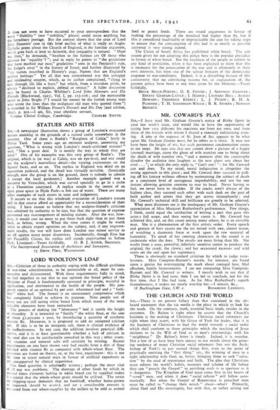STATUES AND SITES
SIR,—A newspaper illustration shows a group of London's evacuated statues standing in the grounds of a ruined castle somewhere in the country. One of them is Rodin's "Burghers of Calais," lately in Palace Yard. Some years ago an eminent sculptor, answering my question, "What is wrong with London's much-criticised statues? " said, " Not a great deal. It is mostly the way in which they are sited." One of his examples was this very group of Rodin's. The original, which is (or was) at Calais, was on eye-level, and one could see the sculptor's marvellous detail—the varying expressions on the figures' faces, and so on. The replica in England was skied on an equestrian pedestal, and the detail was virtually invisible. (Ironically enough, now the group is on the ground, there is nobody to admire it except the local gardeners.) Another example quoted was a statuette by Verocchio, which was carved specially to go in a niche in a Florentine courtyard. A replica stands in the centre of an open grass space in Hyde Park—a fish out of water. There are many other examples of such errors in taste and judgement.
It occurs to me that this wholesale evacuation of London's statues will in due course afford an opportunity for a reconsideration of their siting. I have reason to believe that my sculptor-friend's criticism was admitted by authority to be just, but that the question of expense prevented any rearrangement of existing statues. After the war, how- ever, it would cost no more to put them back right than to put them back, as before, wrong. When the time comes it might be worth while to obtain expert opinions on the subject, and, if any improve- ment results, the war will have done London one minor service to set off against many major disservices. Incidentally, though Eros has left Piccadilly Circus, his replica still stands unperturbed in Sefton Park, Liverpool.—Yours faithfully, G. B. J. ATHOE, Secretary. The Incorporated Association of Architects and Surveyors, 75 Eaton Place, Westminster.

























 Previous page
Previous page